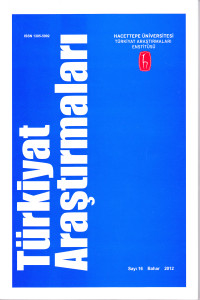Öz
Istanbul with its rich history and inspiring geography has always attracted travellers from Europe and captivated the European mind. Especially, since the early modern times, the Europeans have viewed it not only as a major centre of the classical and Byzantine heritage and eastern Christianity but also, more importantly, as a city which epitomized oriental cultures and civilizations. In this latter sense, it has invariably been mythologized and considered to be a gateway to the Orient. It was certainly with a perception of Istanbul as such that Lord Byron privileged it as “the capital of the East.” In fact, his readings in his early life about the Orient had so much influence on him that, as a young man of 21, he set out in 1809 on a two-year journey, which, beginning from Portugal and Spain, took him to Ottoman Greece and Turkey. In the early summer of 1810 he was in Istanbul for a couple of months and, during his stay, he explored not only the city and the Bosphorus in a historical and geographical context but also had a close look into the Ottoman life and culture. Hence, while, on the one hand, he gave in his letters a colourful account of his impressions and observations of Istanbul, on the other, in his works, especially in Child Harold’s Pilgrimage and Don Juan, he drew a romanticized and fictional picture of the city, situated in an oriental setting and informed by his personal reveries of oriental sensualism and exoticism. So, this paper is a study and discussion of Byron’s oriental fabulation of Istanbul and aims to demonstrate to what extent his fabulation turns Istanbul into an epitome of the oriental Other’s values and ways of life.
Anahtar Kelimeler
Kaynakça
- Lord Byron. (1980-1993). The Complete Poetical Works. (Jerome J. McGann, Ed.), 7 vols. Oxford: Clarendon (For quotation and reference to Byron’s poetry and prose, this edition has been used throughout the article).
- Lord Byron. Childe Harold’s Pilgrimage. In Lord Byron (1980-1993), Vol. II, pp. 3-341.
- Lord Byron. The Bride of Abydos. A Turkish Tale. In Lord Byron (1980-1993), Vol. 3, pp. 107-147.
- Lord Byron. Don Juan. In Lord Byron (1980-1993), Vol. V, pp. 1-771.
- Lord Byron. (2009). Letters and Journals. 5 vols. Newcastle upon Tyne: Cambridge Scholars Publishing.
- Lord Byron. (1990). Byron, A Self-Portrait: Letters and Diaries, 1798 to 1824. Ed.Peter Quennell. Oxford: Oxford University Press.
- Berry, Francis. (1988). “Byron and Greece: From Harrow to Missolonghi.” Lord Byron. Byronism, Liberalism, Philhellenism, ed. M Byron Raizis. Proceedings of the 14th International Byron Symposium, 6-8 July 1987, Athens. Athens: n.p.: pp. 155-164.
- Eisler, Benita. (1999). Byron: Child of Passion, Fool of Fame. New York: Alfred A. Knopf. Franci, Giovanna (1988). “Byron’s Pilgrimage through Greece: Between Classical Ruins and Turkish Masquerade.” Lord Byron. Byronism, Liberalism, Philhellenism, ed. M. Byron Raizis. Proceedings of the 14th International Byron Symposium, 6-8 July 1987, Athens. Athens: n.p.: pp. 165-176.
Öz
Zengin tarihi ve esin kaynağı olan coğrafyası ile İstanbul, Avrupalı seyyahları her zaman cezbetmiş ve Avrupalı’nın zihnini büyülemiştir. Özellikle, Yeni Çağ’ın başlarında, Avrupalılar, İstanbul’u, sadece klasik çağın ve Bizans’ın mirası ve Doğu Hıristiyanlığının önemli bir merkezi olarak değil, aynı zamanda ve daha da önemlisi, Doğu kültürlerini ve uygarlıklarını simgeleyen bir şehir olarak görmüşlerdir. Bu ikinci anlamda, İstanbul sürekli efsaneleştirilmiş ve Doğu’ya açılan bir kapı olarak algılanmıştır. Hiç kuşkusuz, İstanbul’u bu anlamda gördüğü içindir ki Lord Byron onu “Doğu’nun başkenti” olarak tanımlamıştır. Nitekim yaşamının erken yıllarında Doğu’ya ilişkin yaptığı okumalar, Byron üzerinde öylesine etki yapmıştır ki 21 yaşında bir delikanlı olarak, 1809’da, Portekiz ve İspanya’dan başlayıp, Osmanlı yönetimindeki Yunanistan’a ve sonra Türkiye’ye uzanan iki yıllık bir seyahate çıkmıştır. Böylece, bir yandan mektuplarında, İstanbul’a ilişkin izlenimlerini ve gözlemlerini renkli bir şekilde anlatırken, öte yandan eserlerinde, özellikle Child Harold’s Pilgrimage ve Don Juan’da, İstanbul’un romantik ve masalsı bir resmini çizmiştir; bunu yaparken, İstanbul’u bir Doğu dekoru içine oturtmuş ve anlatımını, Doğu’ya yönelik sefahat ve gizem hülyalarıyla zenginleştirmiştir. İşte bu makalede, Byron’ın, İstanbul’u, Doğu bağlamında masallaştırması ele alınmakta ve tartışılmaktadır; ayrıca, bu masallaştırmayı yaparken, Byron’ın, İstanbul’u, ne dereceye kadar Doğu ötekiliğine ait değerlerin ve yaşam biçimlerinin bir simgesi haline dönüştürdüğünün ortaya konulması da amaçlanmaktadır.
Kaynakça
- Lord Byron. (1980-1993). The Complete Poetical Works. (Jerome J. McGann, Ed.), 7 vols. Oxford: Clarendon (For quotation and reference to Byron’s poetry and prose, this edition has been used throughout the article).
- Lord Byron. Childe Harold’s Pilgrimage. In Lord Byron (1980-1993), Vol. II, pp. 3-341.
- Lord Byron. The Bride of Abydos. A Turkish Tale. In Lord Byron (1980-1993), Vol. 3, pp. 107-147.
- Lord Byron. Don Juan. In Lord Byron (1980-1993), Vol. V, pp. 1-771.
- Lord Byron. (2009). Letters and Journals. 5 vols. Newcastle upon Tyne: Cambridge Scholars Publishing.
- Lord Byron. (1990). Byron, A Self-Portrait: Letters and Diaries, 1798 to 1824. Ed.Peter Quennell. Oxford: Oxford University Press.
- Berry, Francis. (1988). “Byron and Greece: From Harrow to Missolonghi.” Lord Byron. Byronism, Liberalism, Philhellenism, ed. M Byron Raizis. Proceedings of the 14th International Byron Symposium, 6-8 July 1987, Athens. Athens: n.p.: pp. 155-164.
- Eisler, Benita. (1999). Byron: Child of Passion, Fool of Fame. New York: Alfred A. Knopf. Franci, Giovanna (1988). “Byron’s Pilgrimage through Greece: Between Classical Ruins and Turkish Masquerade.” Lord Byron. Byronism, Liberalism, Philhellenism, ed. M. Byron Raizis. Proceedings of the 14th International Byron Symposium, 6-8 July 1987, Athens. Athens: n.p.: pp. 165-176.
Ayrıntılar
| Birincil Dil | İngilizce |
|---|---|
| Konular | Türk Dili ve Edebiyatı (Diğer) |
| Bölüm | Makaleler |
| Yazarlar | |
| Yayımlanma Tarihi | 5 Haziran 2012 |
| Gönderilme Tarihi | 1 Kasım 2011 |
| Yayımlandığı Sayı | Yıl 2012 Sayı: 16 |

